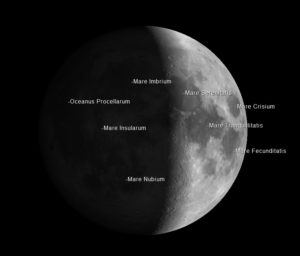Scheduled time for Public Observing: 8pm – 10pm
Solar System Objects:
The moon will be 30° high in the SW at 8pm, and 37% illuminated (waxing crescent phase, 6 days old). Features along the boundary between light and dark show the greatest definition due to the shadows cast by sunlight at a shallow angle. It’s actually sunrise on the moon all along the terminator. Note the variation in terrain from the heavily cratered southern highlands to the plains of Mare Serenitatis, along with the mountain ranges at the north of Serenitatis.
Image (c) Virtual Moon Atlas / http://ap-i.net/avl/en/start
Also, don’t miss the total lunar eclipse beginning at 10:33 Sunday night, January 20, thru 1:50 am Monday morning, with the total phase lasting between 11:41 and 12:43.
Mars will be nearby the Moon, but at a distance of 127 million miles (532 x lunar distance) it appears rather small at 6.9 arc seconds in diameter. This summer’s global dust storm seems to have abated, and the atmosphere has cleared. The polar caps have shrunk to cover only a small area, but may be visible as a bright white specks in the telescope.
The planet Uranus is in good position for observation, also in the SW. It’s currently 1.8 billion miles away and 3.6 arc seconds in diameter, but still easily recognizable as a planet in the telescope, with an intriguing blue-green color.
Deep-Sky Objects:
Listed below are some possibilities of what may be observed tonight, although different objects may be chosen by the telescope operators.
Double Stars:
Gamma Andromeda is a double star, magnitudes 2.3 and 4.8, with a separation of 9.7 arc seconds. The gold and blue colors can be striking in a telescope. Distance: 350 light years.
Gamma Arietis has two evenly matched white components 4.5 and 4.6 magnitude, 7.4″ separation. Distance: 164 light years.
Castor in Gemini is a bright double, magnitudes 1.9 and 3.0, with a separation of 6 arc seconds. Distance: 51 light years.
Nebula and Star Clusters: given the brightness of the sky in Middletown visibility of faint objects is limited, but some brighter nebulae and star clusters still shine thru. A couple examples are:
M42, the Orion Nebula is one of the brightest and most well known nebula in the sky. The central core of this star-forming region should still be visible in the 20″ refractor, even though it will appear fairly close to the moon. It is about 1350 light years away.

M42 photo courtesy Al Johnson Jr, ASGH member.
The Eskimo Nebula (NGC 2392) in Gemini is a planetary nebula with a relatively high surface brightness. The nebula was formed by a solar-type star that ejected its outer layers about 10,000 years ago, and is about 4,000 light-years away. The nebula shows remarkable detail in Hubble telescope images.

NGC 2392 photo courtesy Joe Roberts, see more photos here.

